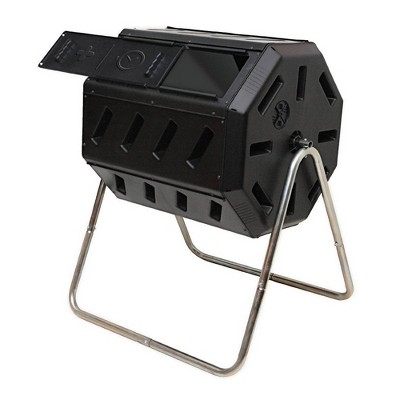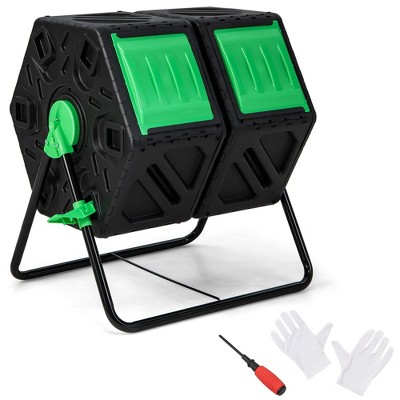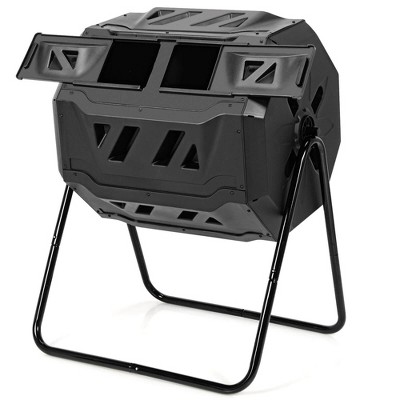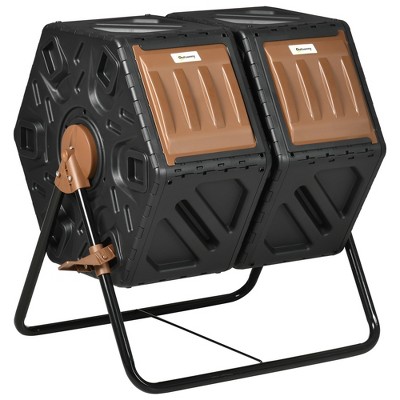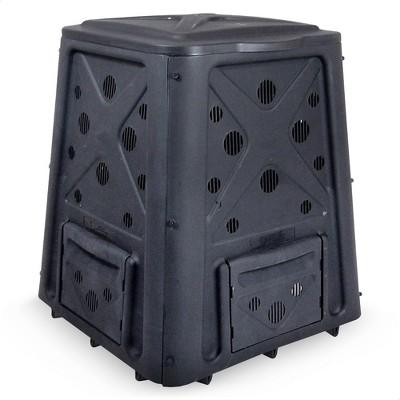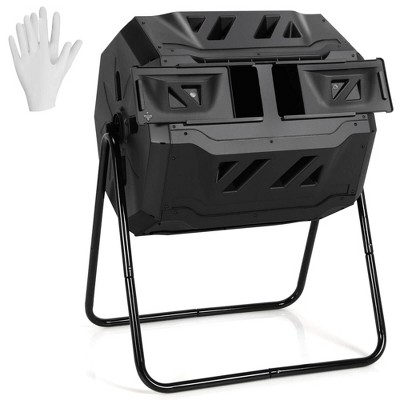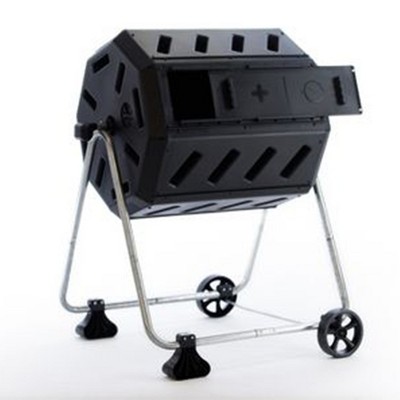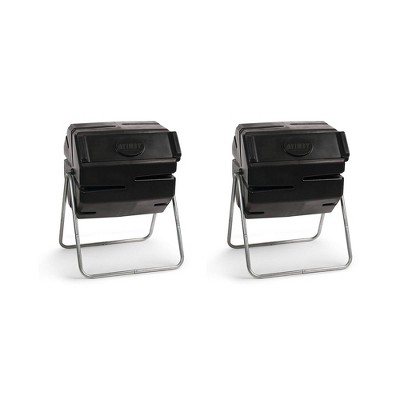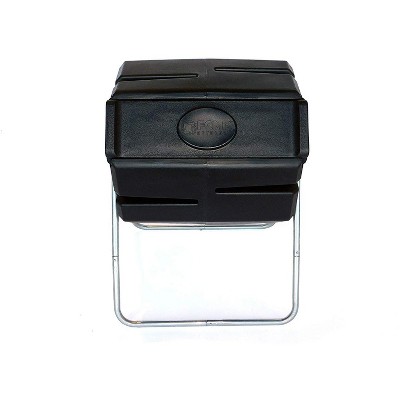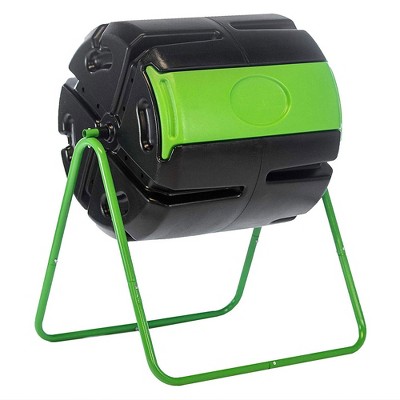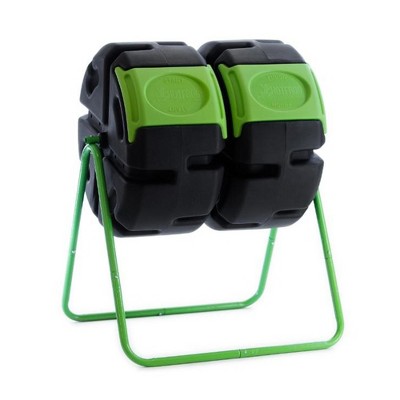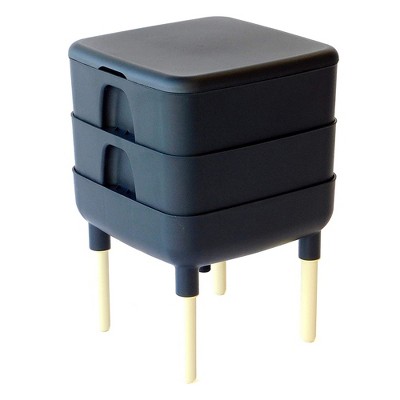FCMP Outdoor Plastic Dual Chamber Tumbling Composter Outdoor Elevated Rotating Garden Compost Bin
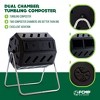
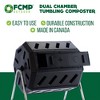
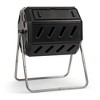

$79.79 sale price when purchased online
$139.99 list price
Target Online store #3991
About this item
Highlights
- ROTATING COMPOST BIN: tumbling composter capacity creates an uninterrupted flow of rich, healthy compost; Integrated wheels allow for easy movement
- 2-WEEK RESULTS: Close the door and turn it 5-6 times every 2-3 days for the perfect balance of ingredients; In hot, sunny conditions and with a proper balance of ingredients the compost can finish in as little as 2 weeks
- OPTIMAL AERATION: Aeration holes as well as deep fins break up clumps inside the chamber and mix lots of oxygen into the compost
- 2 CHAMBERS: Dual-chamber design allows for quick curing, turning your kitchen and yard waste into compost for your soil
- EASY-TO-USE: Large openings and removable door make it easy to add scraps/clippings and remove finished compost
Description
Reduce your kitchen and yard waste by reusing it in this FCMP Outdoor Dual Chamber Tumbling Composter Bin.
Put kitchen and yard waste to use by loading up this rolling composter to create fertile soil for planting and gardening in just a few weeks. This rotating composter is constructed from recycled, UV-inhibited, and BPA-free polyethylene plastic. With its innovative dual-body design, you can fill 1 side while the other side cures.
Reduce and reuse with this compost tumbler's impressive of composting space. Turn this simple composting solution 5 to 6 times every 2 to 3 days to break down the contents. The ergonomic, deep fin handholds make this composter easy to rotate so you don't have to mix your compost by hand. The tough powder-painted steel frame resists rust and will withstand years of outdoor use.
The aeration holes and deep fins break up clumps inside the chamber to maximize aeration and oxygen contact so your kitchen and garden waste breaks down quickly.
Embrace the earth and get an easy start to composting with this Dual Chamber Tumbling Composter Bin from FCMP Outdoor.
Features: Oval (shape)
Dimensions (Overall): 36 inches (H) x 30 inches (W) x 28 inches (D)
Holds up to: 65 pounds
Capacity (Volume): 37 gallon
Assembly Details: Adult Assembly Required, No Tools Needed
Material: Plastic
Warranty: 1 Year Limited Warranty. To obtain a copy of the manufacturer's or supplier's warranty for this item prior to purchasing the item, please call Target Guest Services at 1-800-591-3869
TCIN: 76073502
UPC: 628344138847
Origin: made in the USA or imported
The above item details were provided by the Target Plus™ Partner. Target does not represent or warrant that this information is accurate or complete. On occasion, manufacturers may modify their items and update their labels.
We recommend that you do not rely solely on the information presented. If you have a specific question about this item, you may consult the item's label, contact the manufacturer directly or call Target Guest Services at 1-800-591-3869.
If the item details above aren’t accurate or complete, we want to know about it.
Shipping details
Estimated ship dimensions: 21.1 inches length x 22.2 inches width x 8.4 inches height
Estimated ship weight: 28.9 pounds
This item cannot be shipped to the following locations: American Samoa (see also separate entry under AS), Guam (see also separate entry under GU), Northern Mariana Islands, Puerto Rico (see also separate entry under PR), United States Minor Outlying Islands, Virgin Islands, U.S., APO/FPO, Alaska, Hawaii
item ships from third party seller: Spreetail
Return details
This item can be returned to any Target store or Target.com.
This item must be returned within 90 days of the date it was purchased in store, shipped, delivered by a Shipt shopper, or made ready for pickup.
See the return policy for complete information.
Related Categories
4.4 out of 5 stars with 61 reviews
quality: 4.17 out of 5
value: 4.17 out of 5
87% would recommend
16 recommendations
Not impressed
2 out of 5 stars
Thumbs down graphic, would not recommend
AG - 9 months ago, Verified purchaser
First off, the description says it is dual chamber but after assembling there is only one chamber.. I specifically was looking for dual, so that’s disappointing. Also three days in to using it and it does not contain the smell… started to attract flies too. I have a lot of brown matter in there so I’m not sure where I’m going wrong. They also wouldn’t refund me without returning it and I didn’t discover all of the issues until I started using it so would be a pain to return…
Broken piece
1 out of 5 stars
bullseye246 - 1 year ago, Verified purchaser
Arrived with broken part, which was found after we were partially done with assembly. The only option the target app gives us is to return, but we would just like a replacement for the broken part since we are part of the way done assembling this and to take it completely apart, pack back up and return would be very inconvenient
Small sturdy compost bin !
4 out of 5 stars
michellec1028 - 1 year ago
originally posted on influenster.com

[This review was collected as part of a promotion.] Not sure why but I thought this would come assembled. It’s pretty time consuming to get the pieces together. Great for anyone who wants to compost without a huge pile in your yard. It keeps the pests out but can be leaky in the rain. I like that it’s sturdy but it is on the smaller side. Easy to turn and aerate the compostables. Made in Canada which is a nice plus with less worry about toxins in the body of the bin.
Sturdy, easy to use, & helps utilize waste!
5 out of 5 stars
alyssas491 - 1 year ago
originally posted on influenster.com

[This review was collected as part of a promotion.] This rotating composter is efficient & durable! The odor from the waste is controlled so that you don’t pass out from compost stench! I am very impressed with the capacity to hold quite a bit of compost. This was very fun to assemble! I am very grateful to have the opportunity to make my garden better and utilize waste in a better way! I was sent this product for my honest review.
Easy and effective
5 out of 5 stars
ellief - 1 year ago
originally posted on influenster.com

[This review was collected as part of a promotion.] This was so easy to put together. We started using it right away in our garden. It’s easy to add new compost material and spin the drum. It seems durable so far and I’m excited to put it to work this summer in our vegetable garden.
Love it for compact areas for all new and old composters...
5 out of 5 stars
daniellec507 - 1 year ago
originally posted on influenster.com

[This review was collected as part of a promotion.] I put it together myself and it was relatively easy the direction worked more visually then the description of how to put it together. The overall use of it perfect. Maybe get help putting it together but I would suggest anyone looking to compost and only have a small area to do it this is the perfect solution.
High Quality, Easy Assembly
5 out of 5 stars
rebeccavl - 1 year ago
originally posted on influenster.com

[This review was collected as part of a promotion.] You need a screwdriver and a wrench to assemble this, but the assembly was quick and easy thanks to the straightforward instructions. I haven't used it for composting yet, since it is currently February in Minnesota, but I'm looking forward to using it this upcoming year to help with my garden. The size of this is perfect too, doesn't take up a ton of space in the yard but can still hold a nice volume of compost.
Compact and Easy to Use
3 out of 5 stars
austinc1 - 1 year ago
originally posted on influenster.com

[This review was collected as part of a promotion.] The tumbling composter waste bin has worked well so far. It’s easy to add items to and is simple to spin/rotate. The aeration holes allow for quick breakdown of materials without loss of substance. Assembling the composter, however, was much more of a pain and the instructions (or lack thereof) left a lot to be desired.
Wish it was taller but it works well
4 out of 5 stars
amez - 1 year ago
originally posted on influenster.com

[This review was collected as part of a promotion.] Assembly was a little confusing but this composter works great! I wish it was taller but that's okay, some elevation helps. The little sliding door makes it easy to add more food waste and I can't wait until I can finally use the compost for my garden!!!
Easy assembly!
5 out of 5 stars
- 1 year ago
originally posted on influenster.com

[This review was collected as part of a promotion.] We were so excited to get a composter! Something that has been on our list since we bought our house. We do have a large garden so this will be used a lot. I assembled this composter using very basic tools. It was an easy fit together design and use enclosed hardware and easy peasy it’s done! Tumbles smoothly and perfect size.
Great design and works!
4 out of 5 stars
grishmap3 - 1 year ago
originally posted on influenster.com

[This review was collected as part of a promotion.] 4 stars because it took a while to assemble. The material is good can withstand weight. The design is great, the open spaces in the design allow for aeration. Easy to use.
Spins smoothly
5 out of 5 stars
con_du - 1 year ago
originally posted on influenster.com

[This review was collected as part of a promotion.] This composter is easy to assemble. It spins so smoothly and effortlessly, I’m so impressed! We already compost our kitchen scraps, but have a compost bin through the city. My fiancé and I are excited to have this now, so we can eventually use this for our garden!
Will work great!
4 out of 5 stars
kristinh1438 - 1 year ago
originally posted on influenster.com

[This review was collected as part of a promotion.] This will be great for small kitchen scraps! The instructions are horrible, and we had missing parts but were able to improvise. They do give tips for how to compost and potential problems that may arise while using it with solutions. This had been a great addition to our household and we are excited to keep using it. The quality is really nice and made of recycled plastic!
Solid composter
5 out of 5 stars
marys634 - 1 year ago
originally posted on influenster.com

[This review was collected as part of a promotion.] This composter is solid. Fairly easy to assemble. Seems like it withstand the outdoor environment with ease. Can’t wait to start using it and creating compost for my garden.
"Save the planet while you save the planet"
5 out of 5 stars
bina19_9671 - 1 year ago
originally posted on influenster.com

[This review was collected as part of a promotion.] I am absolutely obsessed with this composter! It's made from recycled materials and is itself recyclable when it reaches the end of its life, and allows me to put all my family's food and plant scraps to good use by turning it into glorious compost. The composter itself weighs about 20 lbs and is neither too big nor too small to be useful for a small household. The diagrams in the instruction manual could have been a bit more detailed, but it was simple enough to assemble that my husband and I put it together in about 20 minutes. The materials are durable and high quality, yet simple and straight-forward. The manual included simple easy to understand directions for making the compost, such as what to put inside at what ratios to achieve the best result and troubleshooting tips. Before adding organic matter, it spun so smoothly that we joked about playing Price is Right, and once some heavy organic matter was put inside, it took a bit of strength to turn, but still rolled smoothly and the hand hold indents make it a breeze. The door slides easily to the side to access the inside or just vent if you need a bit more airflow than the ventilation holes provide. 10/10, this composter will get a lot of use by my family for years to come!
Awesome
5 out of 5 stars
patriciah188 - 1 year ago
originally posted on influenster.com

[This review was collected as part of a promotion.] This composter is so awesome. Great quality and easy to assemble. Can’t wait to use, this is going to be a great addition to helping my garden flourish.
Disappointing
1 out of 5 stars
Thumbs down graphic, would not recommend
Laura D - 2 years ago
When my simple bin style composter finally needed to be replaced I decided to try one that spins. While a great idea in theory - it’s awful. When you spin it all the compost “juice” leaks out and can get all over you. I’ve tried adding twice the number of “browns” (leaves, newspaper, paper bags) to soak up all the liquid, but it hasn’t helped. We’ve had a relatively mild winter here but two days of freezing temps froze the thing solid and impossible to spin since now it was bottom heavy. As for the two sides, one to add to and one to give time to completely break down, I can’t say yet. Again, seems like a good idea but I think an old school bin does a much better job.
So Good!
5 out of 5 stars
Thumbs up graphic, would recommend
AMjac - 2 years ago
Love to add all my kitchen scraps!
Relatively easy to put together. You will need some tools, so keep that in mind! It works well for our small compost pile.
4 out of 5 stars
Thumbs up graphic, would recommend
KJ - 3 years ago
Worth the investment
Great buy!
5 out of 5 stars
Thumbs up graphic, would recommend
MorganM - 3 years ago
Love it! So easy to assemble and works great!
